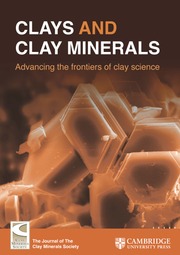Article contents
A Structural Investigation of a Vermiculite-Piperidine Complex
Published online by Cambridge University Press: 01 July 2024
Abstract
A vermiculite-piperidine complex was investigated by a single crystal three dimensional X-ray diffraction procedure. The complex was prepared by ion exchange of a Na-vermiculite at pH 8. A total of 453 reflections was observed and used in the least squares refinement of the structure. The complex is monoclinic, C2/m, a = 5.346(2) Å, b = 9.256(3) Å, c = 17.57(1) Å, ß = 96.29(9)°. The final R value was 0.17 using anisotropic temperature factors for the silicate atoms and isotropic temperature factors for the carbon atoms. The occupancy factors of the C atoms were considered as variable parameters. The diffraction data were of poor quality because of stacking faults. The results show that the molecules are randomly distributed over the crystallographic sites in the interlayer space and the peaks appearing in the electron density maps can be interpreted as being due to 2 piperidine molecules and two H2O molecules. The orientation of the organic molecules is ambiguous. The electron density peaks fit a model in which the molecules are vertical and their planes form a small dihedral angle, and also fit a model in which the plane of the molecules is parallel to (001). It is quite possible that both types of orientations are present.
Résumé
Un complexe vermiculite-pipéridine a été étudié par diffraction X dans les trois dimensions sur monocristal. Le complexe a été préparé par échange d’ion d’une vermiculite Na à pH = 8. Un total de 453 réflexions a été observé et utilisé pour le raffinement de la structure par la méthode des moindres carrés. Le complexe est monoclinique, C2/m, a = 5,436 (2) Å, b = 9,256 (3) Å, c = 17,57 (1) Å, ß = 96,29 (9)°. La valeur finale de R est de 0,17, en utilisant des facteurs de température anisotropes pour les atomes du silicate, et des facteurs de température isotropes pour les atomes de carbone. Les facteurs d’occupation des atomes de C ont été considérés comme des paramètres variables. Les données de diffraction sont de mauvaise qualité à cause des défauts d’empilement. Les résultats montrent que les molécules sont distribuées au hasard sur les sites cristallographiques dans l’espace interfeuillet et les pics apparaissant dans les cartes de densité électronique peuvent être interprétés comme étand dus à 2 molécules de pipéri-dine et deux molécules de H2O. L’orientation des molécules organiques est ambigue. Les pics de densité électronique s’accordent avec un modèle dans lequel les molécules sont verticles et dont les plans forment un angle dièdre petit et s’accordent aussi avec un modèle où les plans des molécules sont parallèles à 001. Il est tout à fait possible que les deux types d’orientation existent.
Kurzreferat
Mit einem dreidimensionalen Röntgenbeugungsverfahren wurden Einkristalle eines Vermi-culit-Piperidinkomplexes untersucht. Der Komplex wurde durch Ionenaustausch bei pH 8 aus einem Na-Vermiculit hergestellt. Insgesamt wurden 453 Reflexe beobachtet und zur Strukturverfeinerung nach der Methode der kleinsten Abweichungsquadrate herangezogen. Der Komplex ist monoklin, C2/m, a = 5,346(2) Å, b = 9,256(3) Å, c = 17,57(1) Å, ß = 96,29(9)°. Der letzte R-Wert betrug 0,17 bei Benutzung anisotroper Temperaturfaktoren für die Silicatatome und isotroper Temperaturfaktoren für die Kohlenstoffatome. Die Besetzungsfaktoren der C-Atome wurden als variable Parameter betrachtet. Die Beugungsdaten waren wegen Fehlern in der Schichtzuordnung von geringer Qualität. Die Ergebnisse zeigen, daß die Moleküle über die kristallographischen Plätze im Zwischenschichtraum zufällig verteilt sind, und daß die in der Elektronendichtekarte erscheinenden Maxima als durch zwei Piperidinmoleküle und zwei Wassermoleküle verursacht interpretiert werden können. Die Orientierung der organischen Moleküle ist nicht eindeutig. Die Elektronendichtemaxima passen in ein Modell, in dem die Moleküle vertikal stehen und ihre Ebenen einen kleinen Winkel bilden. Sie passen auch in ein Modell, in dem die Ebene der Moleküle parallel zu (001) angeordnet ist. Es ist gut möglich, daß beide Arten der Orientierung vorliegen.
Резюме
Данные инфракрасных спектров поглощения и рентгенографических исследований бутиламмониевых комплексов вермикулита показывают, при сравнении с комплексом монт-мориллонита Вйоминг, что тетраэдральное местнахождение заряда определяет манипулиро-вание групп — NН3+ в дитригональные трещины, и что оси С3 этих групп лежат перпенди-кулярно к слоям. Алифатические цепи принимают различные конформации в зависимости от имеющейся при обмене площади: они либо а) если имеющаяся площадь небольшая примут конформацию «all-trапs» с осями наклоненными на 55° по направлению к плоскостям силика-тов, либо б) повернутся 120° вокруг связи С1-С2, чтобы принять плоское положение по отно-шению к слоям, если имеющаяся площадь больше, чем площадь занимаемая органическимионом.
- Type
- Research Article
- Information
- Copyright
- Copyright © The Clay Minerals Society 1974
Footnotes
This research was partially supported by Petroleum Research Fund 2413-C administered by the American Chemical Society.




